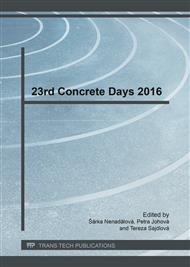p.80
p.85
p.90
p.97
p.101
p.106
p.113
p.119
p.125
Thin Protective Layers Made out of Special Concretes
Abstract:
All concrete and reinforced concrete engineering structures degrade over time when they are exposed to the surrounding environment. In particular, the concrete protective layer of reinforcing steel is rapidly degraded, which can lead to failure of the structure. Adequate durability of concrete coatings must be taken into consideration. This property can be ensured by modifying the composition of the concrete mix. This can be done through the implementation of appropriate admixtures and additives into cement composites. This modification, called material and structural protection, can be used in the form of thin protective layers (TPL). They are intended to protect an ordinary concrete from external aggressions. Thin protective layers made out of special concrete will be presented in the article. The impact of three different thicknesses of protective layers on properties of cement composites was investigated. Special concrete was modified with silica fume, crushed granite aggregate and superplasticizer based on polycarboxylate. Thin protective layers are characterized by very good water resistance and resistance to freezing and thawing. The layer of special concrete with increased durability due to the reduced water/cement ratio, high cement content and by using additives and admixtures, should fully protect ordinary concrete against the negative influence of the aggressive environment.
Info:
Periodical:
Pages:
101-105
Citation:
Online since:
May 2017
Authors:
Keywords:
Price:
Сopyright:
© 2017 Trans Tech Publications Ltd. All Rights Reserved
Share:
Citation:


